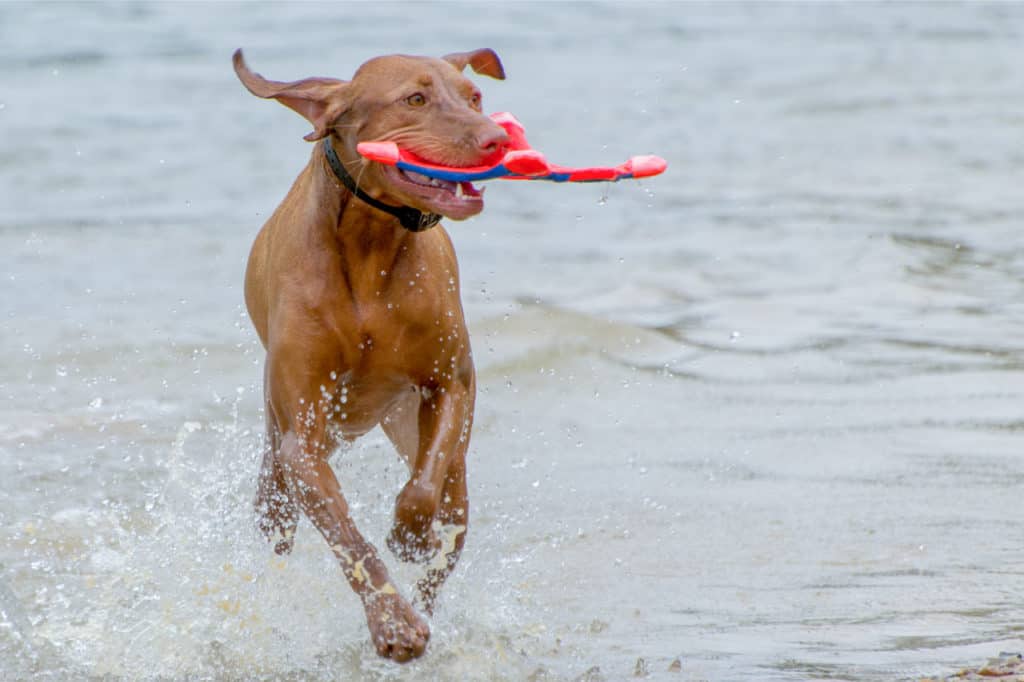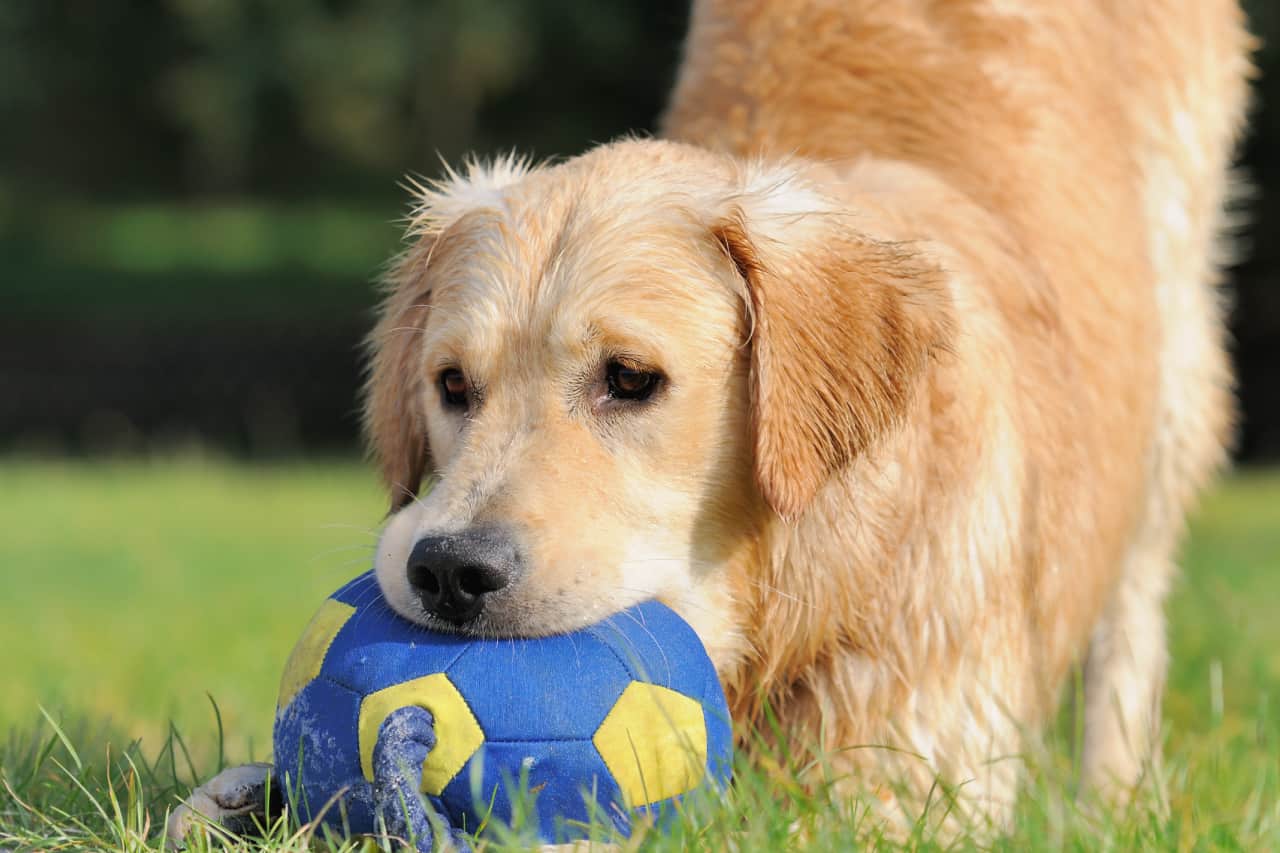You are a first time hunting dog owner and want to make the new family member feel at home. An array of treats and toys are selected, and a plush bed and blanket to complete the gift set. The new puppy gets accustomed to his belongings and soon exerts ownership traits over his toys. This behavior is cute and normal for most dogs, but you have a hunting dog, and you need to be sure about one thing, can hunting dogs have toys?
Hunting dogs cannot have toys. It is not recommended for the gundog or bird dog to have free reign with toys, which will hinder their training. Hunting dogs have to retrieve either a bird or other animal back to its owner. Having ownership over toys can become problematic when the dog has to hand over the retrieve.
You might think it is natural for dogs to have a toy and that it makes no difference to how the dog will respond in the field. Considering the purpose of the hunting dog and what you expect of it, you cannot ignore specific arguments regarding the impact toys have on the hunting dog. Taking an in-depth look we list reasons and arguments below.
What Is A Hunting Dog?
The definition of a hunting dog is A dog breed that has been developed to hunt with humans. There are different types of hunting dogs, for example;
- Sighthounds. Sighthounds are usually lean and fast; they hunt by sight and use their speed to chase and catch prey.
- Scent hounds. Scent hounds were created for their superior tracking ability; they hunt in packs and track, corner, and kill the game.
- Retrievers. Retrievers can track and retrieve shot prey and birds; they are medium to large dogs and are supposed to have gentle mouths.
- Spaniels. Spaniels are used for finding and flushing out small game and birds from under bushed and thickets. They also retrieve shot game to the hunter.
- Pointers. Pointers are used to locate and point the prey to the hunter. They are also able to retrieve the shot game to the hunter.
- Waterdogs. They are dogs that are strong swimmers and used mostly in water birding. They retrieve shot duck and other waterfowl to the hunter.
All of the listed dogs above have very distinct roles and are vital to any hunt’s success. Training takes up much of their time as pups and well into their adult life. Starting by instilling good behavior as a puppy will serve you and the dog well in the field.
The proper training of your puppy with hunting dog-approved toys and equipment is therefore vital. The behavior that you allow at home is what the pup will want to continue with in the field. The puppy must never become confused with what is expected of him.
Why Hunting Dogs Should Not Have Toys
There are a few reasons why hunting dogs should not have conventional toys. Although it might seem as if the dog is being denied stimulation, knowing the possible outcomes can give some insight.
Hunting dogs, specifically gun dogs that retrieve shot game to the hunter, must have a soft mouth. Here are a few reasons hunting dogs should not have toys;
- Encourages selfish behavior. Having free reign with toys can enable your hunting dog to become selfish and hoard the toys. This behavior can manifest in the field.
- Hard mouth. This behavior is almost impossible to train out of a hunting dog once this habit has been formed. The dog will emulate chewing on his toys with the prey, which is the most undesirable trait in any gun dog.
- Aggressive behavior. When you hunt with more than one hunter and multiple dogs, aggressive behavior is not acceptable. A dog can become possessive over a retrieve and fight with other dogs in the field.
- Shake to kill. Very rarely, a hunting dog will display the shake to kill behavior out in the field. It shakes the prey violently side to side to kill it. Floppy toys introduced to young hunting dogs can encourage this behavior.
There are the odd exception to the rule with toys and hunting dogs; however, there is no reason to tempt fate if you need a dependable, stable hunting companion for years to come.
What Types Of Toys Can A Hunting Dog Have?
When you decide to buy a hunting dog, which breed of dog will depend on the purpose for which you need it. There are hunting dogs like catch dogs required to bite and hold the prey, and they need to develop a hard mouth and powerful muscles in the jaw, head, and neck.
This is not the case, however, for upland and water dogs. Precisely the opposite, so what types of toys can your upland or water hunting dog have?
- Nylabone. A Nylabone toy can assist your puppy through the teething phase. Chewing, however, should not be allowed to carry on without supervision.
- Kong chew toy. The Kong chew toy is a safe and durable toy to let your puppy cut their teeth. The Kong toy doesn’t have small parts that can be chewed off and swallowed.
- Puzzle toys. Puzzle toys or do-and-reward toys can assist in neurodevelopment in dogs. This training should only be done for short periods and always supervised.

What Toys Should Your Hunting Dog Not Have?
The list of toys that your hunting dog should not have can be endless. We want to concentrate on the most critical toys to avoid and the reasons;
- Plush Toys. Plush toys make the puppy want to bite and hold on or shake the toy. This undesirable behavior in a field trial will be an immediate disqualification.
- Tug of war toy. It would be best if you avoided tug-of-war ropes and rings at all costs; the tugging backward causes the dog to bite down harder, and it is now fighting you for ownership. A hard mouth retriever is very undesirable and will damage your prey.
- Floppy dummy. When training your puppy, ensure the canvas dummy you use does not have floppy sides; this will also encourage the shake-to-kill behavior. Choose a good quality training dummy that comes in various shapes and sizes.
- Squeaky toys. Squeaky toys are probably the least desirable toy on this list. When the puppy bites down and the toy squeaks, the puppy thinks the toy is being killed and will continue biting down repeatedly.
- Ball toys. The ball is on the list for two reasons; firstly, the sensation of resistance a tennis ball gives the dog when biting down makes it hard for the dog to stop, and it will continue to bite down repeatedly, as in the case of the squeaky toy. Secondly, the ball often turns into a self-rewarding toy where the pup will paw the ball, throw and catch it again.
- Sticks. Throwing sticks for your hunting dog can cause injury to your hunting dog’s mouth; also, avoid letting your dog retrieve sharp sticks out of water.
- Dead birds. Your hunting dog should not be allowed to play with a dead bird. This will cause your dog to want to eat it and should only be used for training much later.
If you spend sufficient time training your hunting dog, they will be mentally stimulated and become physically fit and healthy. Hunting dogs are usually brilliant and require daily training and exercise.
Is There A Difference Between Male And Female Hunting Dogs?
The preference between having a male or female hunting dog is mostly personal. Below we table some differences between the two sexes.
| MALE HUNTING DOG | FEMALE HUNTING DOG |
| More dominant in the field. Less Likely to work in a larger pack with several males. | Less dominant and more likely to work well together with several other females. |
| No heat cycle. Can spend more days in the field. | If not spayed, coming in heat will prevent the dog from working for a month at least. |
| It is physically larger and more robust, which is beneficial on specific hunting trips. | It is smaller in build and does not have the same physical strength. Tires easier. |
| Marking territory can become a tiresome habit if your male is not neutered. | Females do not mark territory as male dogs do. |
| Can be more affectionate. | Can display mood swings if not spayed. |
Conclusion
It may seem a little cruel not to let your hunting dog puppy have unlimited access to various toys. The dog’s purpose is to hunt in the field, performing tasks not assigned to the average house pet. It requires a level of discipline and determination from both to shape an obedient and well-rounded upland or water dog. There is no reason not to give your hunting dog puppy a toy, except that fixing a bad habit formed early in a hunting dog is almost impossible later.

